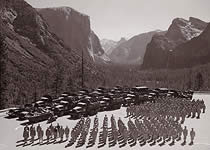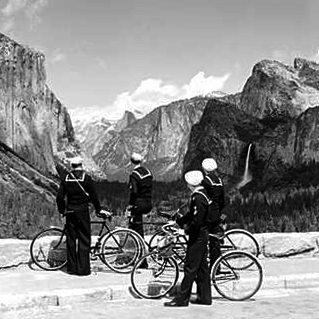In WWII, Yosemite National Park joined the rest of the nation in its 'all-hands-on deck' efforts to support the war effort. In addition to the men and women of Yosemite that served in the Armed Forces, those that stayed beyond made their contributions. Park and concession staff provided searched for downed military aircraft in the park. WWII Yosemite came to life with visiting soldiers, victory gardens, blood drives, a US Navy Hospital and a US Army Signal Corps training camp.
After the Japanese Attack on Pearl Harbor, Yosemite National Park joined national parks across the nation in efforts to protect precious park resources while joining the war effort. Over 200 men and women from Yosemite’s population of 1,000 residents, served in the armed forces during the war. Wartime park Superintendent Frank A Kitterdge had been an officer in World War One. Kitteredge organized and became chair of the local Red Cross Chapter, organizing many drives and efforts throughout the war. Like many park superintendents, Kitteredge was also fighting efforts to harvest Yosemite’s natural resources for the war effort, including demands to open its meadows up to grazing for beef production. Kitteredge instead organized Victory Gardens around park maintenance areas to provide aid to the war effort without damaging Yosemite’s precious ecosystem.
U. S. Army Signal Corps at Yosemite

National Park Service
During the latter part of April 1943, authority was granted the army for the occupation of the former Wawona Civilian Conservation Corps camp by several hundred men of the 426th Signal Battalion, Camp Pinedale, California, for special training. During December 1943, negotiations were completed for the transfer of the former Wawona CCC camp to the Western Signal Aviation Unit Training Center, Camp Pinedale, and the army stationed a small unit at the camp to protect its property. U. S. Army Signal Corps units utilized Park Service facilities both at Wawona and Badger Pass as special summer training schools.
US Navy Hospital in WWII Yosemite

National Park Service
The “U.S. Naval Convalescent Hospital Yosemite National Park, California” was commissioned on June 25, 1943. Eleven days later, the first patients arrived. They were veterans of the Battle for Okinawa.
The Navy’s operation at Yosemite was initially intended for neuro-psychiatric rehabilitation. The thinking was that shell-shocked patients would respond well to the peaceful setting of an isolated scenic facility. In fact, the site quickly proved to be exactly the opposite of what these patients needed. The towering cliffs caused many to become claustrophobic. Isolation and lack of diversionary social or entertainment outlets left their disturbed idle minds preoccupied with the very memories the Navy hoped to erase. Within a few months, hospital administrators wisely decided to phase out psychiatric treatment at the Ahwahnee and convert the facility into a general physical rehab unit.
During the time the hospital was in commission 6,752 patients were admitted. Of these about 65% were returned to duty and the remainder discharged from the Service. The greatest number of patients at any one time was 853. While Navy men dominated the hospital’s patient list, soldiers, Marines, and Airmen also stayed at the hospital.
By the time the hospital was decommissioned in December 1945, rehabilitation at Yosemite’s newly renamed “Special” Hospital had dramatically changed from what the first patients experienced a year and a half earlier.
Military Plane Crashes in Yosemite
In addition to the U.S. Navy recouperation hospital at Yosemite, the only other military use of the park during World War II related to military plane crashes. On 27 June 1943, a B-24 bomber collided with Koip Peak, located near the east park boundary. All seven crewmen aboard died in the accident. The wreckage was discovered by a Curry Company employee, and the bodies were packed out by park personnel.
On April 13, 1944, a USAAF Douglas P-70A from Hammer Field at Fresno, California, was involved in a radar training flight with another aircraft. The target aircraft had to return prematurely, and it lost track of the other plane, which subsequently crashed at Given’s Creek (Farabee 2005; Mireles 2006).
Just a few months later on August 28, 1944, another USAAF Douglas P-70 (P-70B) from Hammer Field crashed into the summit of Quarry Peak, 15 miles west of Mono Lake. Three airmen were killed in the accident. The cause of the crash was never determined (Mireles 2006). Wreckage was scattered over a 500 foot area, and is still in place (Macha and Jordan 2002).
Last updated: November 20, 2015
